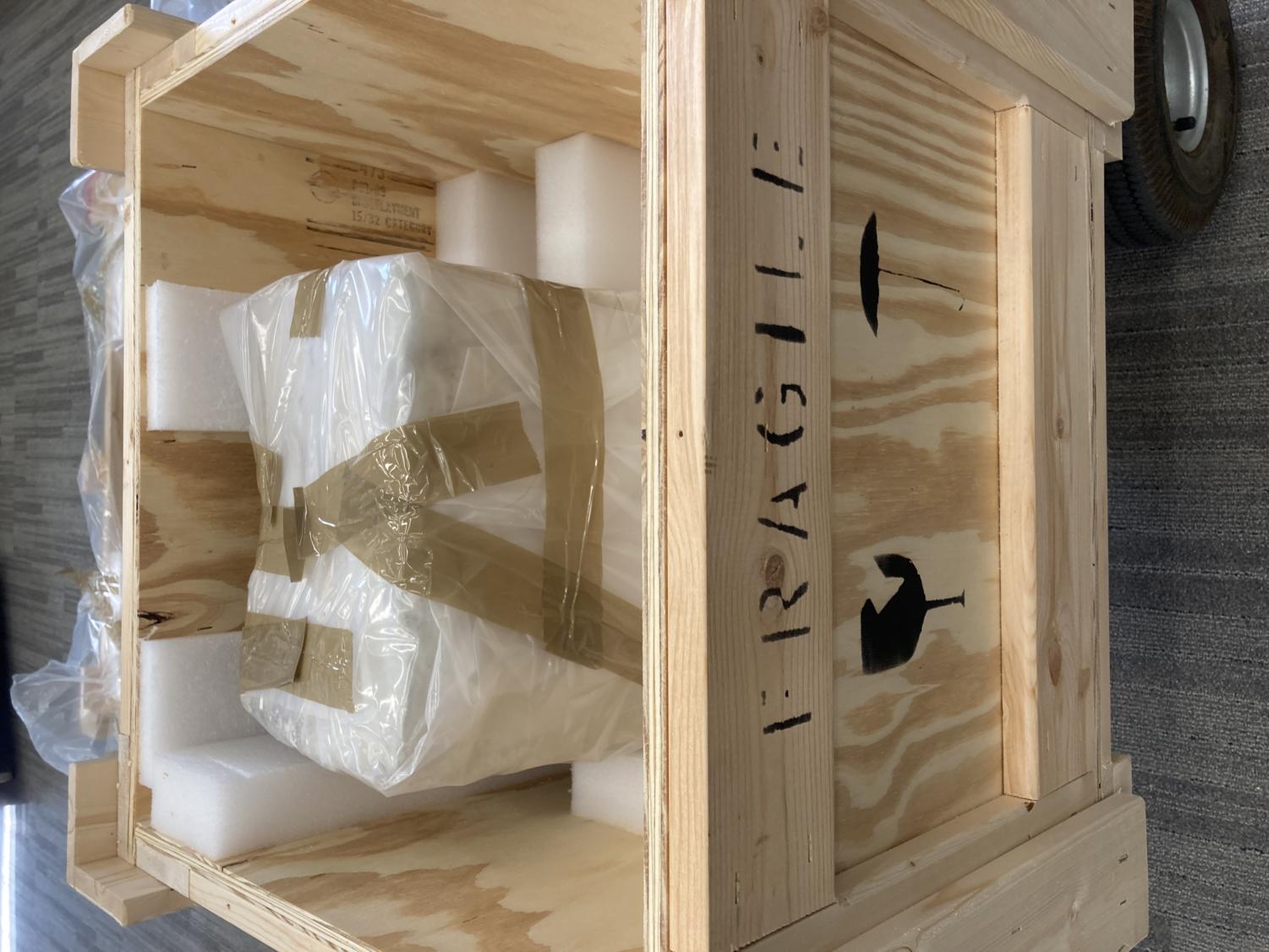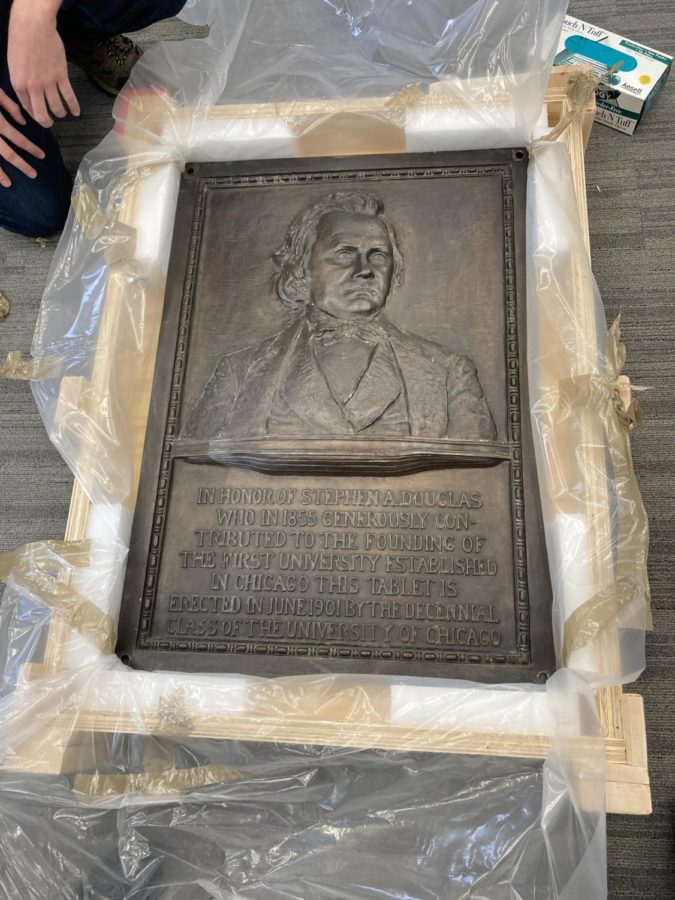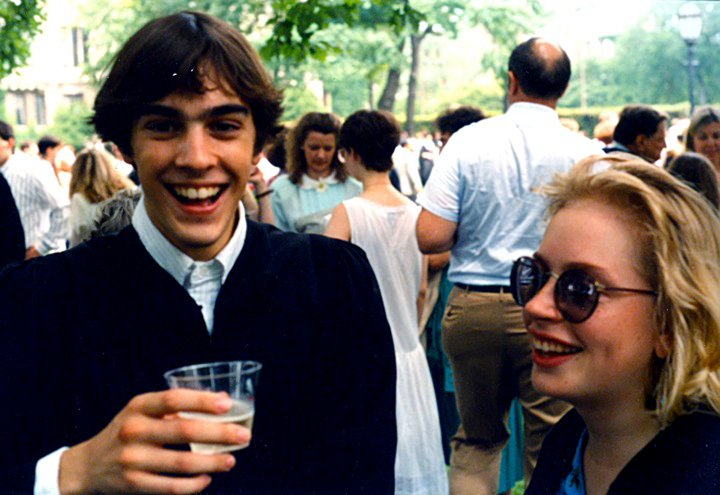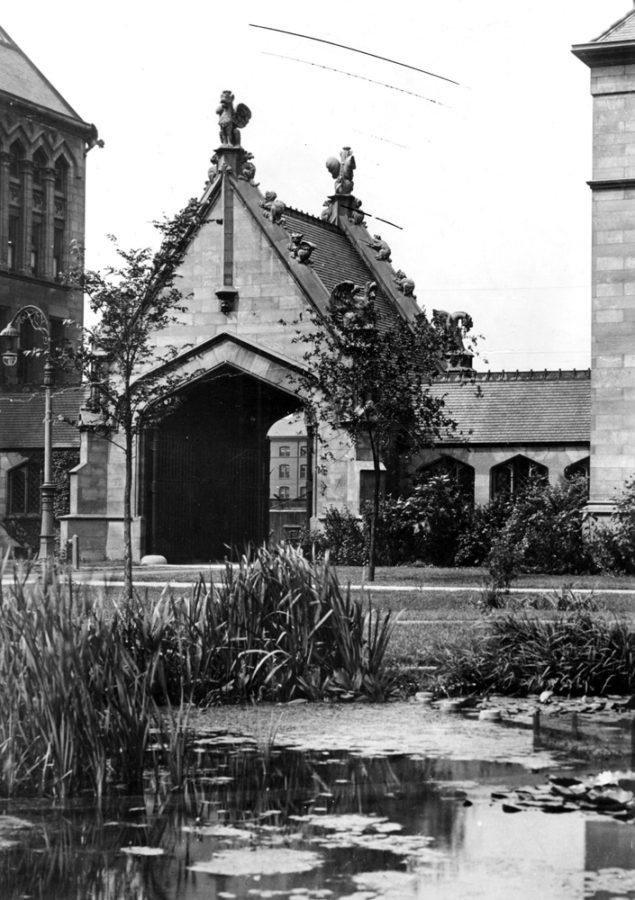For over 119 years, the University of Chicago community has passed through Reynolds Club largely unaware of the presence of the U.S. Senator, enslaver, and founder of the Old University of Chicago, Stephen A. Douglas, looking out at them from a bronze plaque. If they walked southwest toward Ellis Avenue and 59th Street, they would have passed a stone from Douglas Hall at the Old University of Chicago, installed in the outside wall of the Classics building sometime between 1928 and 1931.
On July 7, 2020, then president Robert Zimmer announced the stone and plaque had been removed from campus and would be relocated to the archives of the Hanna Holborn Gray Special Collections Research Center. The removal came as a surprise to many, since no community or campus group had called for their removal and no information had been shared with library staff before the announcement. Zimmer asserted in his email that the relics were removed because “Douglas does not deserve to be honored on our campus.” President Zimmer presented this act as an end in itself “toward building a stronger, more inclusive University of Chicago,” while at the same time denying any accountability for Douglas’s crimes against humanity. This begs the question: What has their removal accomplished?
Removing these relics without campus or community involvement was an attempt to shut down conversation about them, creating confusion and feelings of alienation. What could have been an opportunity to address the history of racism at the University instead was an attempt to erase that history. This history must be confronted and addressed as a community. We spoke with several archivists, organizers, University staff, and instructors to gain a broader perspective. Through this article, we hope to spark the conversation Zimmer suppressed: a community-wide discussion about the future of the Stephen A. Douglas relics.
As a member of the original Reparations at UChicago (RAUC) working group, a Black graduate student, and an archivist, history Ph.D. candidate Caine Jordan maintains that the relics of Douglas hold a great deal of meaning to him. “As a member of RAUC, the group that uncovered and publicized the ties between Stephen A. Douglas, the University of Chicago, and slavery, the Douglas relics mean both truth and pain: truth in the sense that the people who made the University of Chicago possible can have their stories told, and pain in the sense that the brutality of slavery—hidden in plain sight—must be unearthed to adequately and completely repair its harms.” The relics of Douglas hold remnants of one of the most consequential and excruciating periods in American history and serve as a reminder that the blood of slavery invisibly runs through many institutional bricks. “As an archivist at the Special Collections Research Center, the relics of Douglas existing at my workplace, with little acknowledgement from the UChicago administration on their legacy, is troubling. The relics of Douglas should have a description that accurately documents this history and the events leading to its accession in the archives. Archival description and access are essential, but University administration is responsible for acknowledging this history and events as well.”
Starting in 2016, RAUC drew attention to the presence of these memorials to Douglas on campus. Their research connects Douglas to the current University of Chicago and thus establishes a line of enrichment from Douglas’s enslavement of Black people on his plantation to the wealth and prestige of the present University. RAUC’s work grew from the research done by Sherry Williams of the Bronzeville Historical Society. Williams and researchers transcribed the Register of Enslaved People in Douglas’s Papers to read aloud before events and honor the labor of these people, such as performing a libations ceremony at the Stephen A. Douglas Tomb in honor of the enslaved peoples of the Douglas Plantation. Williams does not agree with the decision to place these objects in the University archives. “I believe de-accession to another location should be considered. Descendant communities of the enslaved Africans are likely to not see, touch or experience the relics. Don’t forget the paywalls and restrictions to access of UChicago’s libraries and spaces is real…Possibly the plaques could ‘rest’ inside of Douglas’s Tomb…just a thought.”
The RAUC has argued “central to the process of reparatory justice is community involvement, community repair, and transforming the institution itself to prevent future harm.” While these relics represent immeasurable harm, a community conversation that recognizes and centers that harm holds the potential for reparative justice. The University announced the formation of the Council on UChicago/Community Relations on December 17, 2021, with the charge of “researching and preparing a report that reflects upon and illuminates the history and relationship between the University and the city’s South Side neighborhoods.” We asked Guy Emerson Mount, a founding member of the RAUC, to comment. “With the formation of the Council on UChicago/Community Relations, the University’s administration has opened the door to undoing the horribly cynical blunder enacted by the previous administration that brought these objects to Special Collections in the first place. That council, not the upper administration, should now decide through a wide process of community engagement (with Black Chicago at the center) what should happen to these objects. If the community wants them displayed, they should be displayed. If the community decides to smash the stone to rubble and melt the plaque down and create a monument to the enslaved, the administration should not only facilitate that but fund it.”
Mount sees significant issues with the makeup of the council that could undermine its charge. “The membership of that council needs to expand dramatically to reflect the wide ideological diversity of Black Chicago and must include organizations familiar with reparations and transformative justice as it relates to this particular case including the National Coalition of Blacks for Reparations in America (N’COBRA), Black Lives Matter, Good Kids Mad City, the Chicago Association of Black Psychologists, and the Bronzeville Historical Society. All these organizations have been actively participating in the reparative process that has already been happening for years now without the administration’s sanction. These organizations have been quite clear in their previous statements regarding what would constitute repair for the University’s historical ties to slavery, Jim Crow, and ongoing acts of anti-Blackness. To cut them out of this process now (when this new administration seems open to some kind of a reparative process) would be a horrible mistake.”
President Zimmer removed these objects in response to the uprisings against policing in the spring and summer of 2020. But why these objects? Who removed them and when? Who decided to deposit them in the archives and why? We spoke to multiple administrative staff and faculty members across campus and were unable to find answers to these questions. The MoreThanDiversity campaign quoted President Zimmer’s email in their demand for reparations, as part of their larger five-part Call to Action. Paul Rand, Vice President for Communications, informed us that the University has not shared anything besides the details in their original announcement. It seems that the decision to remove these objects was made unilaterally and the vast majority of us learned about it when it was announced.
We don’t know the details around the removal of the relics, but we have learned quite a bit about where they are now and future plans for them. We spoke to Kathleen Feeney and Ashley Gosselar in the University archives, who explained that “the plaque and stone were delivered to the library in summer 2021 by Facilities Services after their removal, and they were received by two now-retired staff members at the Hanna Holborn Gray Special Collections Research Center.” The objects are available to anyone. “When we are not under pandemic restrictions, the Hanna Holborn Gray Special Collections Research Center is open to all researchers, and does not require affiliation with the University of Chicago. Like all materials in Special Collections, these items have to be viewed here at the Center and cannot be checked out of the library. They are too large and heavy to bring into the center’s reading room, but we can unpack the crates in one of our classrooms for patrons to see them.”
The research center is open to all researchers, but most library and campus spaces are highly restricted to members of the public. The ubiquitous presence of University of Chicago Police Department (UCPD) officers on campus sends the message that members of the public are not welcome. Black men especially are disproportionally stopped by UCPD.
Zimmer’s justification for removing these relics was because “Douglas does not deserve to be honored on our campus.” While these celebrations of an enslaver are no longer openly displayed on campus for any and all to see, they have received the “honor” of accession into the University archives, along with the papers of all past University presidents, prominent faculty papers, and a copy of most books published by the University of Chicago Press. And whereas these relics were once mostly accessible to anyone who wished to see them (to the extent that our campus is accessible to the public), they are now further removed from the public and only accessible through the Hanna Holborn Gray Special Collections Research Center. How can we as a community begin to address the harm these objects represent, when realistically, community members do not even have access to them?

While the plaque and stone have been accessioned into the University archives, Feeney and Gosselar note that they are still deciding which collection within the archives is most appropriate for them: “Archival collections are usually named for their creators, in this case the Old University of Chicago and the University of Chicago’s Class of 1901. We are considering if this is the best way to identify these artifacts or if their discoverability might be improved by identifying them as records of the University of Chicago Facilities Services, the department which administers the care, renovation, and construction of campus buildings.”
Since the center is short-staffed, the work may take some time.
Discussions about how to describe documents and artifacts related to atrocities and historical trauma responsibly and sensitively are taking place throughout the archival and museum community. According to Feeney and Gosselar, approaches to this work vary: “Some institutions use content warnings and other statements about potentially harmful language, and some include information about mental health resources in their guides or exhibitions. What all information professionals agree upon is the importance of thinking critically about the ways in which our policies and practices facilitate or hinder our efforts to document and contextualize difficult histories.”
Feeney and Gosselar also describe archival description as an evolving and iterative process. “As time and resources permit,” they explain, “we try to provide full descriptions of collections and we practice reparative description work. For instance, we recently redescribed our Slavery in North America Collection. The finding aid now includes all available names of persons described in the documents, as well as their roles (enslaver, enslaved person, etc.). Exposing these names on the internet will greatly aid researchers, especially genealogists.”
The University of Chicago Library is a member of two Chicago-area consortiums that help archivists collaborate, the Chicago Collections Consortium and the Black Metropolis Research Consortium (BMRC). The BMRC’s offices are located in the Regenstein Library. In addition to maintaining consortial partnerships, archives collaborate with community-based organizations on a variety of initiatives including the conservation and preservation of collections. “At the same time, it is important that community-based archives maintain their autonomy,” says Marcia Walker-McWilliams of the Black Metropolis Research Consortium. “Engaging community partners requires time and effort to build equitable relationships. Unfortunately, archives and libraries are not usually funded and supported to the levels that they should be to support meaningful and equitable community engagement.”
According to Walker-McWilliams, “statements on harmful content as mentioned above are often a part of interpretations and exhibition of controversial objects. Archivists and exhibition curators often consult subject experts to determine what language, terms or analysis are best to use in an exhibition. And often more information, context and analytical tools are provided for the objects. This can help people understand why the objects are on display and…to make their own meaning out of the objects.”
Addressing harm and decolonizing collections requires time, resources, and the will to invest in these projects. There are no shortcuts to do this work. Marcia Walker-McWilliams told us, “sometimes, archivists and collection professionals decide not to display controversial objects out of concern for the public, because their institutions direct them not to, or because they don’t have the staff capacity or knowledge to interpret the objects.”
The University of Chicago Library has long been ranked well below its peers for staffing levels. In 2019, we had the ninth largest collection in North America but ranked 46th in total wages and salaries expenditures. This situation has been exasperated by the pandemic. While the library has posted a number of positions over the past year, the archival staff has been reduced by 75 percent over the last six years. Feeney and Gosselar explained, “when our unit rebuilds, outreach and collaboration with the community will be a core component of what we hope our staff can do. In the meantime, we were glad to see the president’s announcement on December 17, 2021 about a new Council on UChicago/Community Relations: Historical, Contemporary, and Future. As the council conducts its research about the historical relationship between the University and the surrounding community, we hope that they will make use of the wealth of information available to them in the University archives, and we look forward to helping them find the resources they need.”
Without community involvement and financial and material resources from the University, we cannot adequately address the harm these relics represent. They are physical manifestations of the University’s enrichment from slavery. This reality demands reparations. As Guy Mount explains: “Reparations are not something given unilaterally by the person, nation, or institution responsible for the harm. Reparations are something demanded by those who have been harmed and represent a willingness to work collaboratively with the offending party to meet the needs arising from that harm. This is because reparations are a permanent revolution–a new way of being in the world. They are not a project but an ongoing praxis. In this way, reparations are a durable argument that will continue to be made by survivors as long as those survivors survive. It is true that the harms of UChicago’s ties to slavery can never fully be made right. But justice now demands that the entire campus community commit to a process and embrace a seemingly paradoxical principle—that even the most irreparable harms must be repaired.” Placing them in a box in the basement doesn’t change that.
What do you think should happen to the Stephen A. Douglas Relics? Please share your comments.
Caine Jordan is a Ph.D. candidate in history and a co-founder of the Reparations at UChicago Working Group (RAUC). Anne K. Knafl is the Bibliographer for Religion, Philosophy, and Jewish Studies at the University of Chicago Library. Nancy Spiegel is the Bibliographer for History, Art History, and Cinema and Media Studies at the University of Chicago Library.













